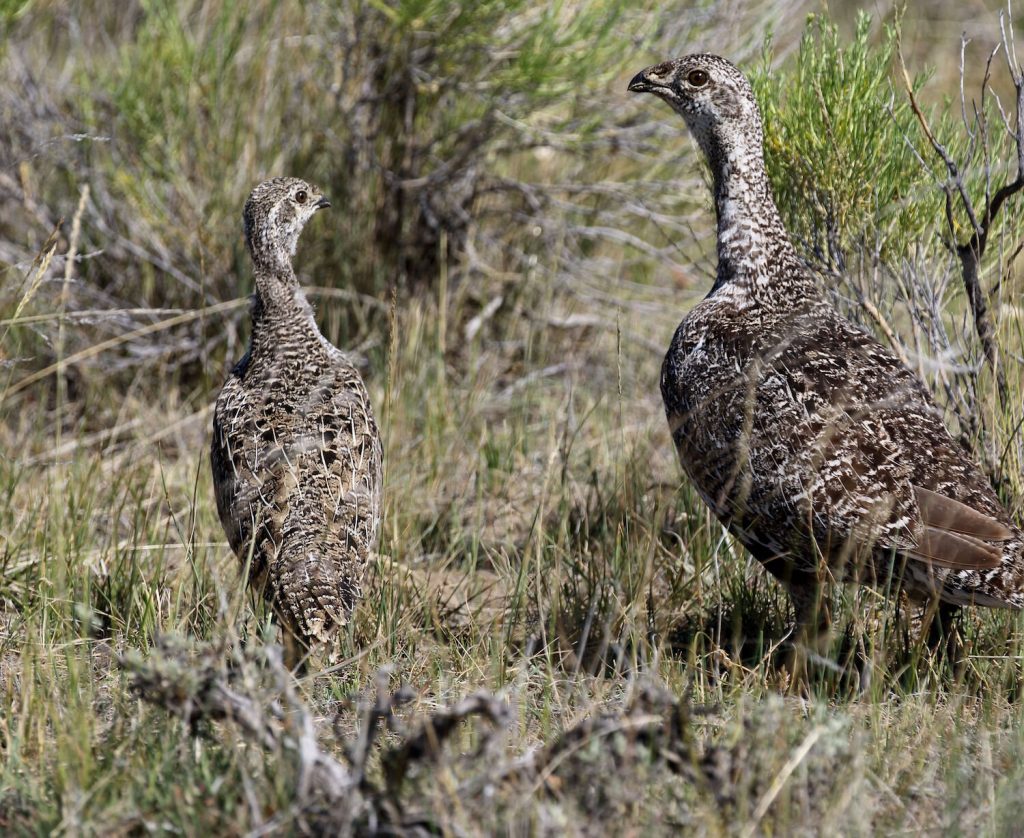Sage grouse at Wilson Gulch in Fremont County, Wyoming. Credit: Stanley Harter/Wyoming Game and Fish Department
Efforts to improve sage grouse habitat through conventional management practices may be ineffective—and even counterproductive—according to research by University of Wyoming and other scientists.
Sagebrush reduction strategies, including mowing and herbicide application, are often employed to enhance habitat for the greater sage grouse and other sagebrush-dependent species. The theory is that clearing large sagebrush shrubs improves food sources in sage grouse nesting and brood-rearing habitats by allowing other, more nutritious vegetation to grow with less competition. This, in turn, should increase invertebrate populations, another food source for sage grouse.
But a new paper published in the journal Wildlife Monographs suggests these methods may be misguided.
In a nine-year experimental study, researchers examined how sage grouse populations in central Wyoming responded to mowing and applying the herbicide tebuthiuron to Wyoming big sagebrush. According to their data, these treatments did not benefit the birds.
“Some managers think, ‘Treating sagebrush for wildlife is how it’s supposed to work, and we’ll keep doing it,'” says Jeff Beck, a UW professor of ecosystem science and management and principal investigator for the study. “Hopefully, this will get people to start thinking, ‘If we’re going to spend money to improve habitat, we’ve got to find some other ideas.'”
The researchers tracked behaviors and survival rates of more than 600 female greater sage grouse in response to mowing and tebuthiuron application. They also monitored effects on invertebrate populations, sagebrush and herbaceous vegetation. Throughout the study, responses were compared to untreated plots near the treated areas as well as off-site control plots.
Pretreatment data were collected from 2011–13; mowing and tebuthiuron applications were implemented in winter and spring 2014.
After six years (2014–19) of post-treatment monitoring, Beck and his colleagues determined that sage grouse responses to treatment were neutral at best.
“Neither mowing nor tebuthiuron treatments influenced nest success, brood success or female survival,” they reported.
Furthermore, treatments used to reduce Wyoming big sagebrush coverage resulted in slight avoidance by sage grouse.
Invertebrates and herbaceous vegetation also did not respond positively to reduction of Wyoming big sagebrush, indicating treatments did not improve the quantity and quality of sage grouse food sources.
Instead, reduction of Wyoming big sagebrush cover may negatively impact sage grouse and other species that use sagebrush shrubs to nest and seek refuge from predators, the researchers suggest.
They predict that expanding experimental treatments to larger areas may reveal greater negative effects of Wyoming big sagebrush reduction on sage grouse populations.
“Management practices that focus on the maintenance of large, undisturbed tracts of sagebrush will best facilitate the persistence of sage grouse populations and other species reliant on the sagebrush steppe,” they wrote.
Their results are consistent with many other studies suggesting that controlling Wyoming big sagebrush negatively impacts wildlife. However, they caution, their findings should not be generalized to other sagebrush species and subspecies, such as mountain big sagebrush.
Rather than removing Wyoming big sagebrush, Beck says, conservation strategies should focus on removing encroaching pinyon and juniper and invasive species such as cheatgrass. These types of vegetation alter the sagebrush ecosystem and influence fire cycles, potentially damaging sage grouse habitat.
Enhancing wet areas in sagebrush habitats is another promising strategy for improving the quality of sage grouse brood-rearing habitat, he notes.
More information: Kurt T. Smith et al, Response of greater sage‐grouse to sagebrush reduction treatments in Wyoming big sagebrush, Wildlife Monographs (2023). DOI: 10.1002/wmon.1075
Provided by University of Wyoming
Citation: Research questions value of sagebrush control in conserving sage grouse (2023, June 26) retrieved 4 July 2023 from https://phys.org/news/2023-06-sagebrush-sage-grouse.html
This document is subject to copyright. Apart from any fair dealing for the purpose of private study or research, no part may be reproduced without the written permission. The content is provided for information purposes only.

